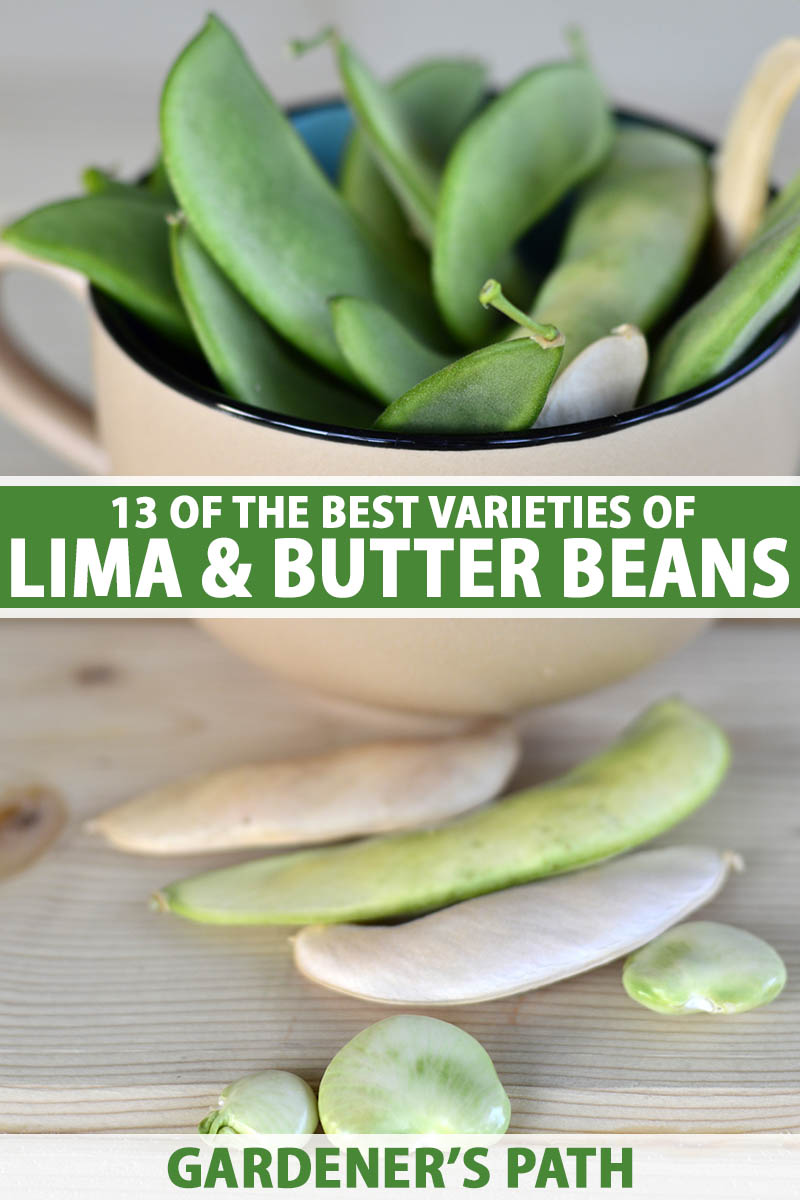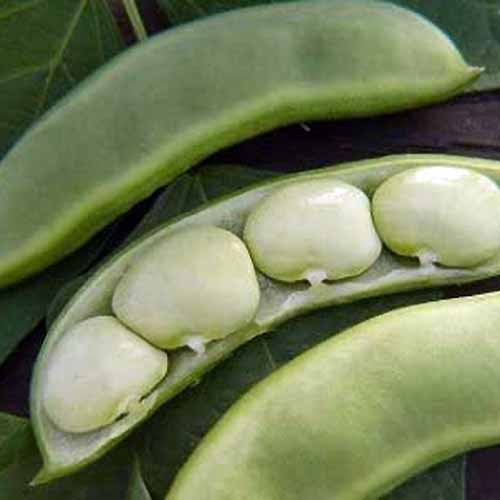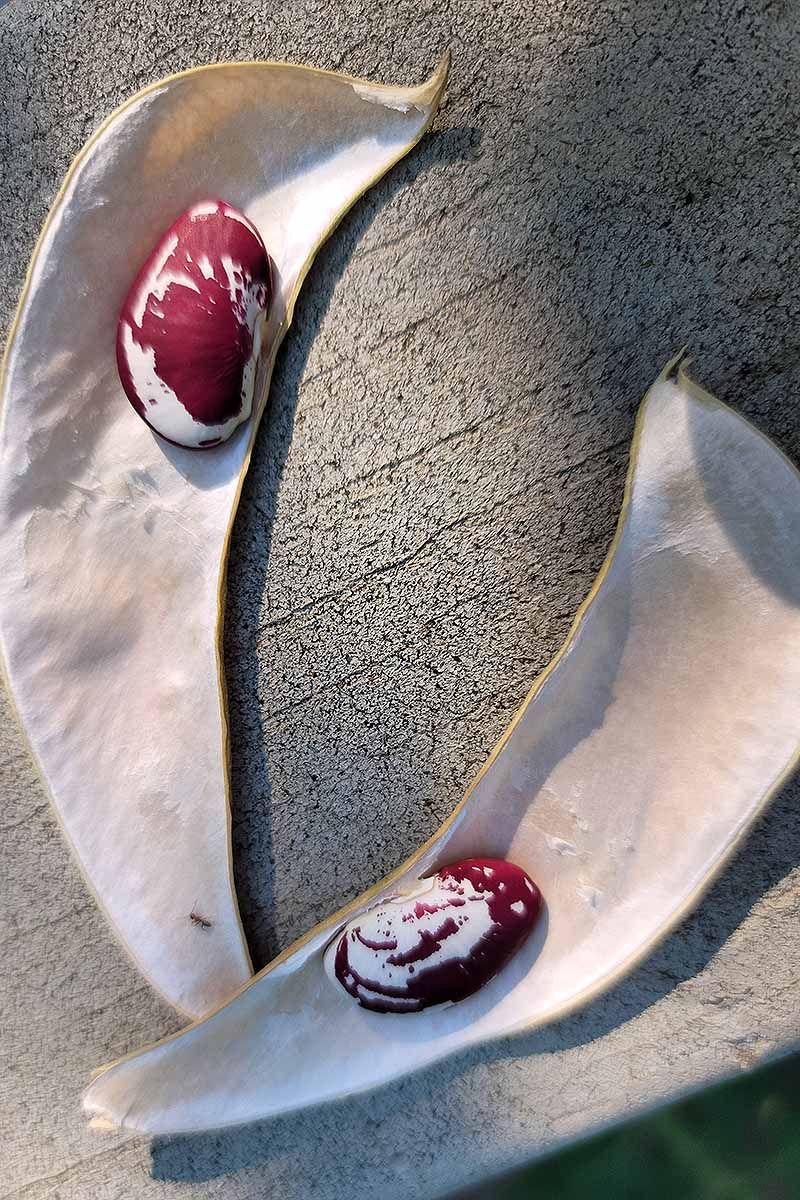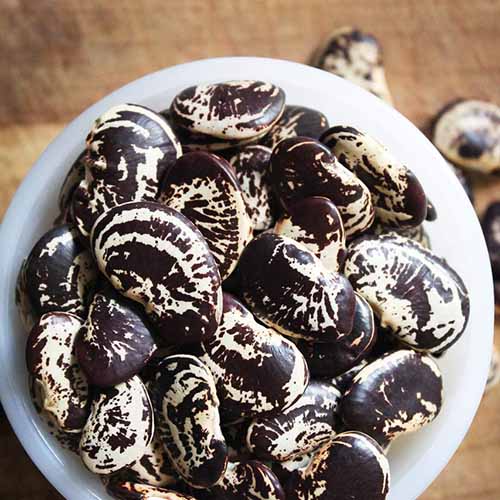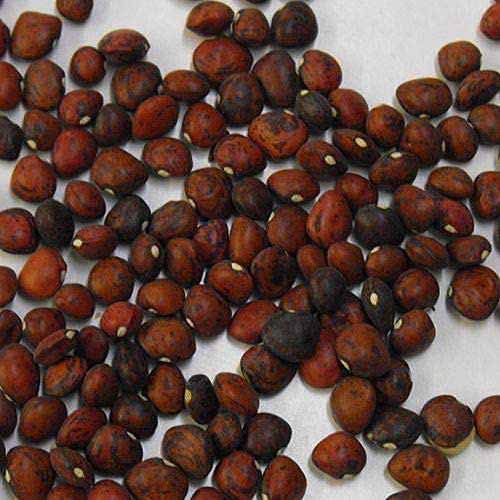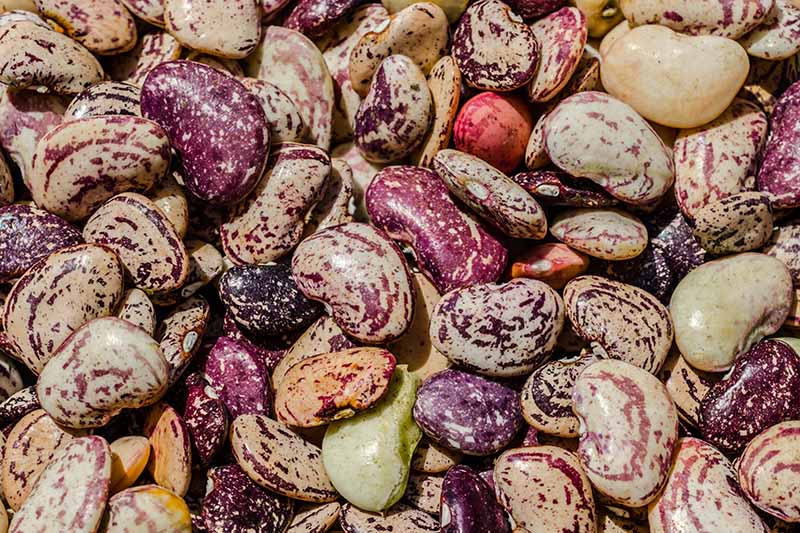The folks of decades and even centuries past were probably so busy eking out every last seed to dry, pressure can, and freeze for their hungry families that they didn’t have the time to categorize what they grew in any detailed fashion. That could be the reason why so many varieties of Phaseolus lunatus, also known as the butter bean, have casual nicknames or broad descriptors. For example, artisanal dried bean distributors and heirloom seed sharers alike often just use the label “large lima” to cover most of the types that produce white, buff, or light-green colored seeds that exceed an inch or so. And then there is “butterpea,” which loosely describes a few types with pebble-size seeds, though they are not high in fat, butter-colored, or any type of pea (Pisum sativum). We link to vendors to help you find relevant products. If you buy from one of our links, we may earn a commission. Unlike those Victory gardeners and truck farmers of the late 1800s, post-World War I, and Great Depression eras, though, I have plenty of time to differentiate between cultivars that are available to grow. I’ll detail a range of tender, tasty possibilities, from bush varieties that produce early enough for short-season gardeners to the mighty pole bean varieties that yield giant seeds and need almost 100 days of hot sun before harvest. To make it simple to start growing those that catch your eye, I’ll also share sources for most of my selections. Here are the top picks I’ll share: Okay, here we go! Get ready to learn about the best varieties of a garden vegetable that is tasty, prolific, and easy to preserve by drying or freezing. Open-pollinated ‘Baby Fordhook’ matures in 70 to 75 days, on plants that are just 12 to 18 inches tall. ‘Baby Fordhook’ Each three-inch pod yields three or four tiny white seeds that are firm and a little sweet. I eat them fresh from the green pod or steam them for a side dish, but they’re considered ideal for pressure canning, freezing, and drying, too.
2. Big Mama
Big on extra-large butter beans for cassoulets and soups? Here you go! This pole variety will grow eight to 10 feet tall. Staking is a must, and I’d recommend an arbor, fence, or trellis to support the powerful vines. They produce eight-inch-long pods in lavish quantities, each with three to five beans inside that are the size of the bowl of a teaspoon. ‘Big Mama’ does take 80 days to reach full size and produce green pods with shellies inside, and another few weeks for the pods to turn brown so you can harvest the dried beans. But that’s a short window compared to most pole varieties, which usually start producing from 90 to 110 days from sowing. ‘Big Mama’ Kids in particular take to giant limas like this one, because they retain their shape in cooking and don’t get too mushy. Plus, you can top the cooked beans with marinara sauce, minced garlic, and fresh mozzarella and heat it under the broiler for a healthy take on pizza night. ‘Big Mama’ is available in three-ounce seed packets from Burpee.
3. Burpee Improved
This variety was established and first sold by Burpee in 1907. Always popular, the improvements have just made it even more vigorous and high-yielding. A bush variety that grows 18 inches tall, ‘Burpee Improved’ is known for its thick, four- to six-inch pods that contain four or five plump white beans each. ‘Burpee Improved’ It takes 75 days to mature. You can eat the seeds shelled and steamed when the pods are green, or harvest them dry a few weeks later when the pods have turned brown and brittle. ‘Burpee Improved’ is available in one- and four-ounce packets and one-pound sacks from Eden Brothers.
4. Christmas
This is one of my very favorite cultivar names. I love how it was named for the holiday even though it doesn’t have seeds or blooms with the traditional Christmas red and green, nor is the foliage used in wreaths. But the smooth, large, buff-colored seeds with swirls of deep maroon are a joy to behold, and they’re definitely a gift to gardeners who need to grow heat-tolerant vegetables. And the foodies describe the taste as “chestnut,” which is so appropriate. (But please don’t roast them on an open fire.) All these traits do make ‘Christmas’ the perfect name for these butter beans. An heirloom variety, ‘Christmas’ dates to the 1840s and had its heyday in the early 20th century. Speaking of great cultivar names, some also call them calico beans, or chestnut limas. I recommend this cultivar for anyone looking for high yields, as long as you’re able to support the vigorous vines that grow six to 10 feet. They add even more weight as they load up with four- to six-inch pods, each containing two to five of those two-tone, tie-dyed-looking beans. ‘Christmas’ One more wonderful aspect of ‘Christmas’ beans is the way they cook up. They keep their shape, lovely colors, and buttery texture even after steaming or stewing. That’s merry, indeed.
5. Dixie Speckled Butterpea
I don’t think Southerners who stocked up on this sublime dried soup bean were real worried about whether to divide “butter pea” into two words or not, so I don’t either. But you will notice that some purveyors list it this way. Instead, I enjoy being able to grow this pebble-size bean that’s prolific and highly adapted to hot summer growing conditions like mine. It’s a variety of P. lunatus, but it looks different than most, with three or four dark red and magenta seeds per four-inch pod. A bush variety, this butterpea grows about two feet tall. ‘Dixie Butterpea Speckled’ It takes 76 days to mature, which is about a week longer than its ‘Dixie Butterpea White’ counterpart.
6. Early Thorogreen
Short growing season? Prefer container gardening, or have that as your only option? You can still grow limas if you choose a bush variety like ‘Early Thorogreen.’ It reaches 18 inches tall, which means there’s no need for support in the form of stakes, fences, or trellising. Taking 69 days from sowing to producing three-inch pods, each is filled with three or four light green beans that are famed for their tender texture and buttery taste. ‘Early Thorogreen’ ‘Early Thorogreen’ is one of the fastest-maturing varieties you can find. It’s great for those in northern climates, or successive planting in areas with longer growing seasons. ‘Early Thorogreen’ seeds are available in one-ounce packets as well as half-pound and one-pound sacks from True Leaf Market.
7. Florida Speckled
A pole variety with plants that grow to 10 feet tall, ‘Florida Speckled’ produces medium-size white seeds with sassy maroon splashes of color. ‘Florida Speckled’ This variety requires a full summer to grow to maturity, about 95 days. But after the wait is over, just a few plants will yield gallons of dry and fresh shell beans from four- to six-inch pods.
8. Fordhook 242
‘Fordhook 242’ is a well-known, large-seed lima you may have seen in the grocery store freezers. It’s sometimes referred to as “potato lima” by the old timers. Homegrown, these beans are extra tender and a little sweet, with a signature flavor reminiscent of hazelnut. The plants are compact, growing just 18 inches tall with bushy foliage. They take 75 days to reach maturity. Introduced by the USDA in the 1940s, ‘Fordhook 242’ produces a harvest quickly, making it an optimal selection for gardeners in northern climates. ‘Fordhook 242’ It’s also heat- and drought-tolerant, and will keep producing clusters of four-inch pods with three to five beans each throughout the hot summer months, and right up to the first frost. ‘Fordhook 242’ seeds are available in one ounce and one-, five-, and 25-pound sacks from True Leaf Market.
9. Henderson
A vegetable best described as an “oldie but goodie,” ‘Henderson’ is America’s favorite baby lima. An heirloom bush variety that’s easy to grow in the garden or in containers, it thrives in summer heat and grows only 18 inches tall. It’s good for successive planting in places with long growing seasons, since it takes just 60 to 70 days to mature and begin producing bushels of three- to four-inch pods with three or more seeds each. ‘Henderson’ Its speed is also appreciated by those with short growing seasons. Hey, northerners deserve buttery, tender lima beans, too! ‘Henderson’ seeds are available in one- and four-ounce packets and one-pound sacks from Eden Brothers.
10. Jackson Wonder
This heirloom bush variety is a marvel – high-yielding, great-tasting, and fast. It’s also one of the many varieties developed to withstand the summer heat in southern growing regions. It takes 68 days to grow to its mature height of 24 inches, and set three-inch pods with three or four speckled seeds apiece. ‘Jackson Wonder’ The seeds are pretty, kind of a purplish-brown that looks like autumn, and they dry well. Just don’t expect them to hold their shape in cooking, though they’re a great choice for bean soup or hummus. ‘Jackson Wonder’ seeds are available in half-ounce and one-, five-, and 25-pound sacks from True Leaf Market.
11. King of the Garden
A vegetable garden’s equivalent to the Prom King, ‘King of the Garden’ is a handsome pole variety that produces six (count ‘em) seeds per pod. It was introduced in 1883 and still reigns supreme, if you’re looking for tender white shell beans that also dry well to stock the pantry. The vines grow very tall, eight or nine feet, and need support from a trellis. I grow mine on an arbor with fence panels on the side and top for extra support. You have to wait 88 days for the ‘King’ to start producing, so successive planting is out of the question. ‘King of the Garden’ But fear not, this popular pole cultivar yields such a bounty of pods, one harvest is usually enough for fresh eating and a dried supply for the winter pantry. ‘King of the Garden’ seeds are available in one-ounce packets and in bulk from True Leaf Market.
12. Wick’s
This type is an heirloom that’s a darling of the Seed Savers Exchange. The vines are ”semi-pole,” growing to three to six feet tall in around 80 to 90 days. They produce dark green pods with seeds that might be white with maroon or burgundy flecks, or almost 100 percent dark purple. This variety originated with Wick Smith of Sandyville, West Virginia, who established it in the 1930s. He passed it down to family members who kept “growing it out” for an ample supply of seed. It eventually reached the Seed Savers Exchange in 2004, as a gift from Smith’s grandson. You don’t have to sacrifice vigor to grow this variety with a multigenerational back story. ‘Wick’s’ is known for its slightly curved pods, colorful beans, and most of all, its adaptability. Warm-weather gardeners praise its heat tolerance, but it’s also successful in northern climates when you plant it after the danger of frost has passed and tend it so it grows quickly.
13. Willow Leaf
An heirloom pole variety, ‘Willow Leaf’ reaches maturity in 90 to 100 days. It has a unique trait, leaves shaped like those of the willow, hence its name. The plants typically reach eight to 10 feet in height, but the three-and-a-half-inch pods produce smaller, almost baby limas in creamy white with a rich flavor.
Looking for Lima Beans in All the Right Places
Are you just trying to get an idea of what’s out there? Or are you a gardener who’s actively seeking a specific cultivar you know you want to plant? Either way, I hope you enjoyed perusing this collection of varieties I consider top notch. If you know of one I’ve missed or have your own favorite, would you kindly share your input in the comments section below? And should you be looking for more info on any aspect of growing legumes, I think you’ll enjoy reading these bean guides next:
What’s the Difference Between Butter Beans and Limas?How to Grow Bush BeansPlant Green Beans and You’ll Feel like a Gardening ProHow to Grow Black-Eyed Peas
